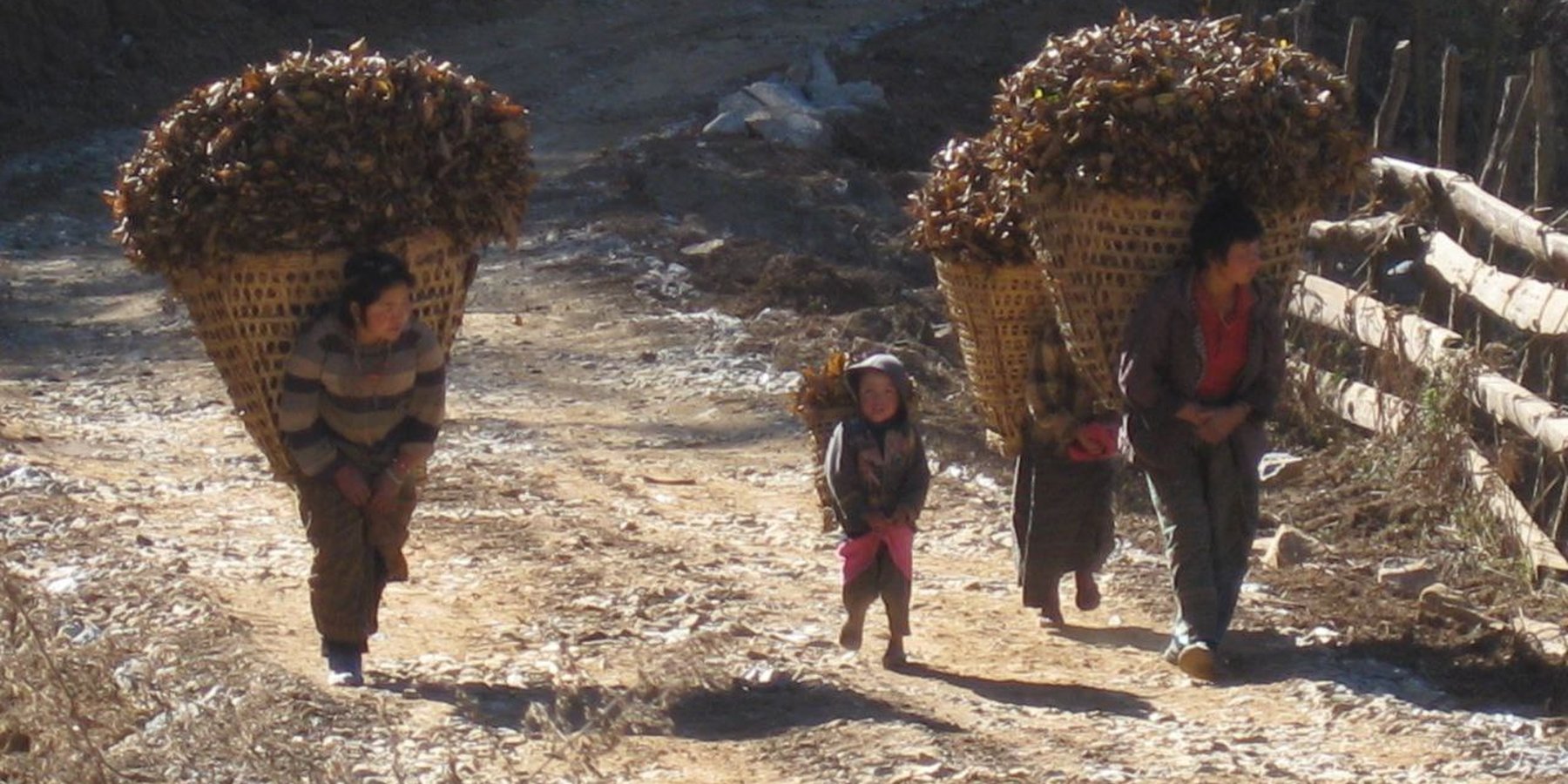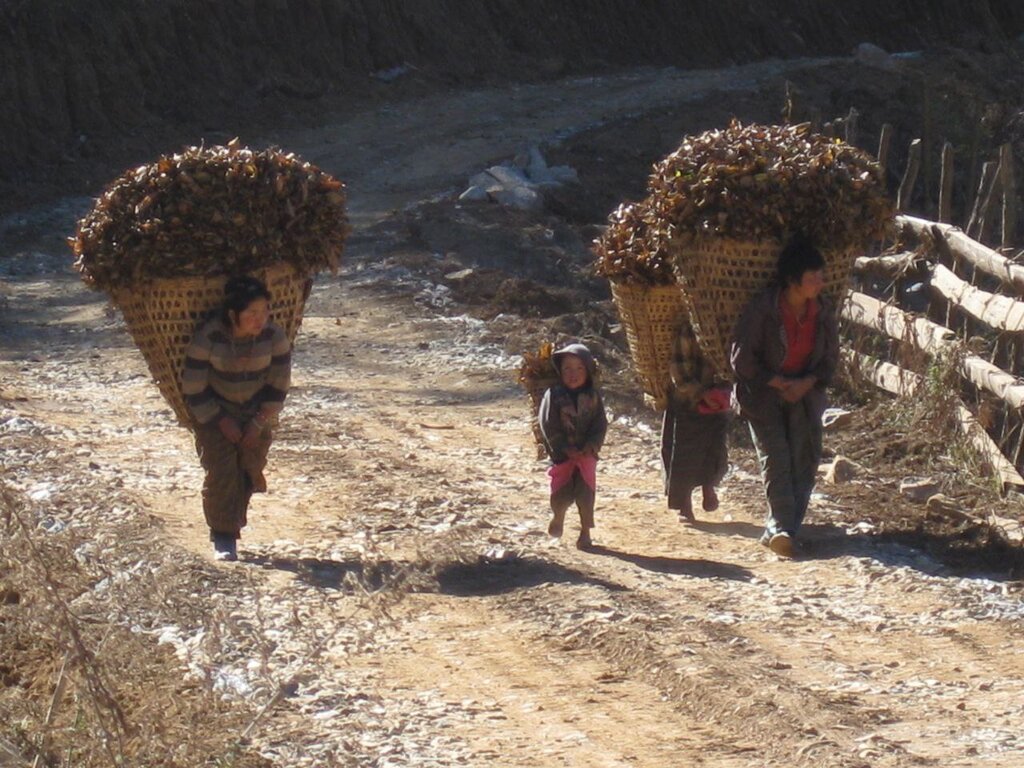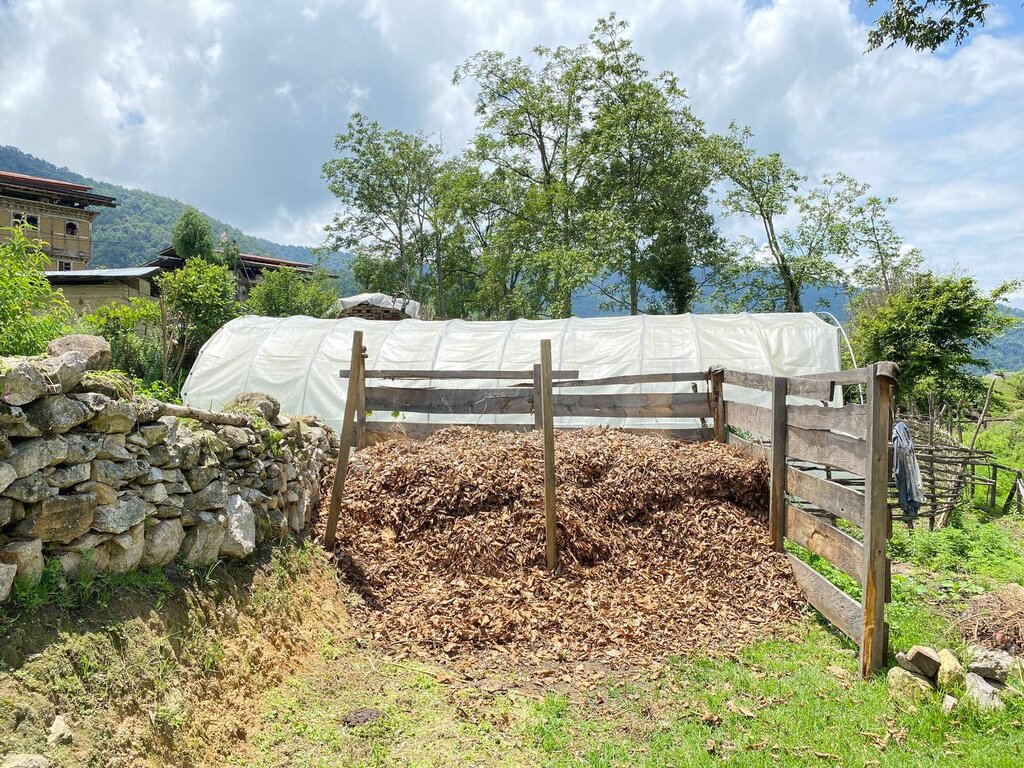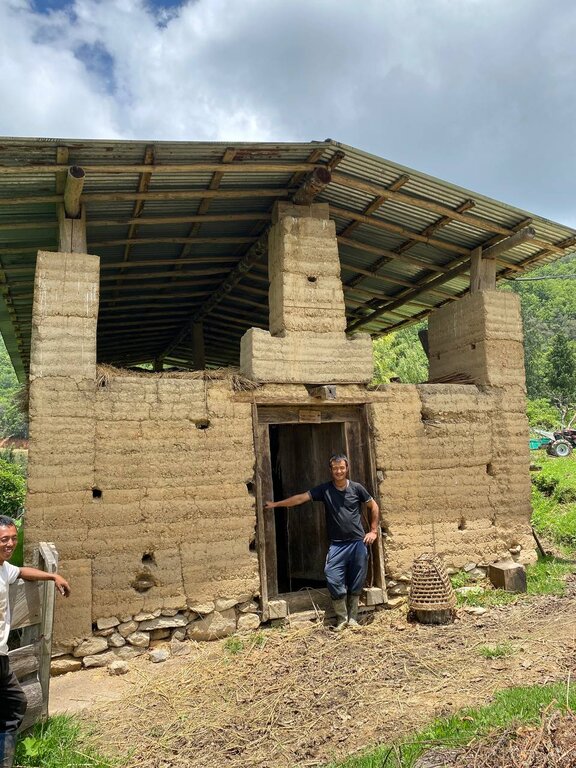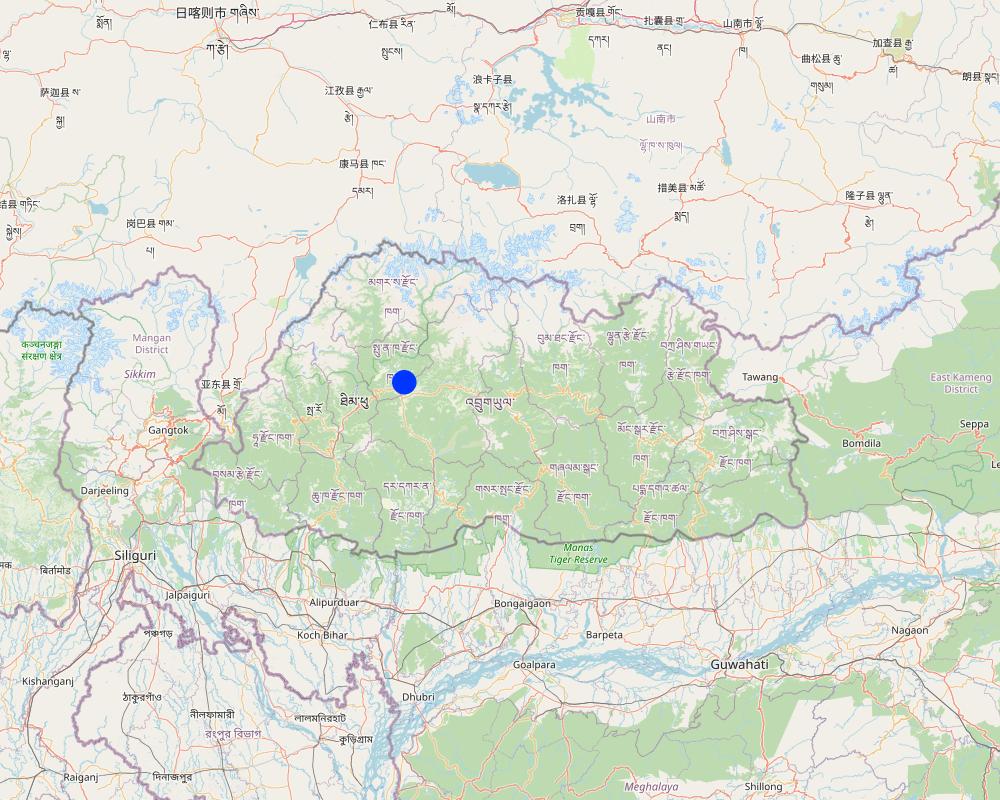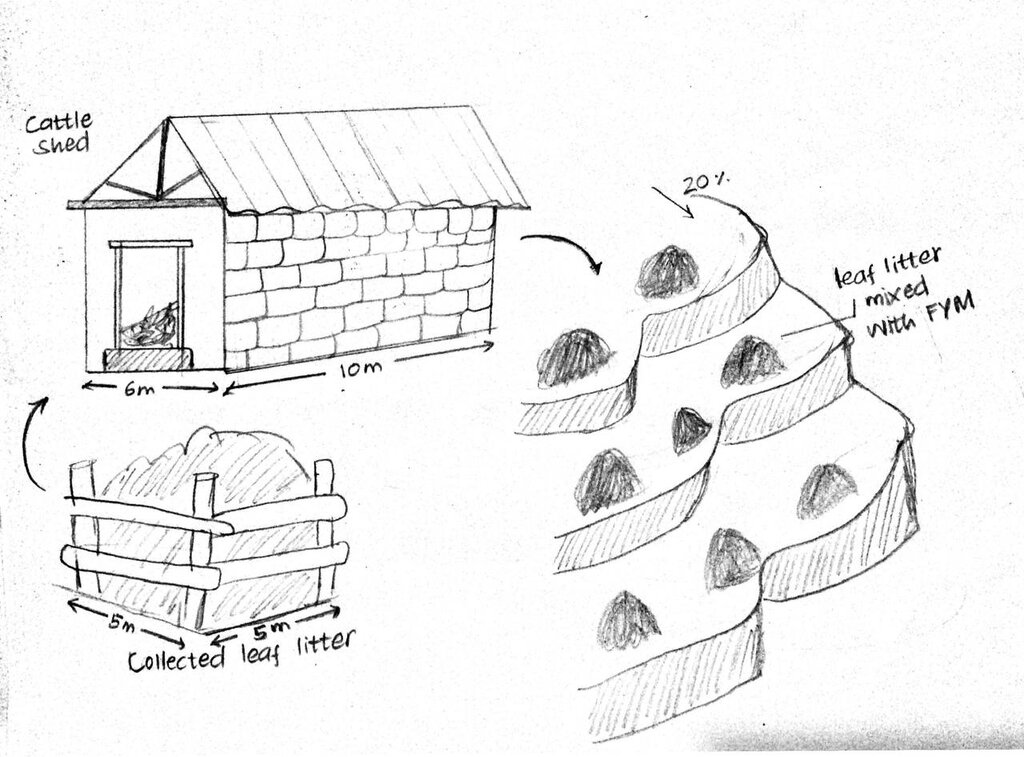Leaf Litter Collection for FYM Production [不丹]
- 创建:
- 更新:
- 编制者: Karma Wangdi
- 编辑者: Tashi Wangdi
- 审查者: William Critchley, Rima Mekdaschi Studer
Sochhag Tey Nor Lue Zhoni (གསོ་འཕྱག་སྟེ་ནོར་ལུད་བཟོ་ནི།)
technologies_6818 - 不丹
查看章节
全部展开 全部收起1. 一般信息
1.2 参与该技术评估和文件编制的资源人员和机构的联系方式
关键资源人
土地使用者:
Norbu Dawa
Lingmukha Chiwog (Community), Lingmukha Gewog (Block), Punakha Dzongkhag (District)
不丹
有助于对技术进行记录/评估的项目名称(如相关)
Strengthening national-level institutional and professional capacities of country Parties towards enhanced UNCCD monitoring and reporting – GEF 7 EA Umbrella II (GEF 7 UNCCD Enabling Activities_Umbrella II)有助于对技术进行记录/评估的机构名称(如相关)
National Soil Services Center, Department of Agric (National Soil Services Center, Department of Agric) - 不丹1.3 关于使用通过WOCAT记录的数据的条件
编制者和关键资源人员接受有关使用通过WOCAT记录数据的条件。:
是
1.4 所述技术的可持续性声明
这里所描述的技术在土地退化方面是否存在问题,导致无法被认为是一种可持续的土地管理技术?:
否
注释:
This technology is practiced for decades without any problems regarding land degradation. While leaf litter collection can have positive effects when managed sustainably, there are also potential negative impacts associated with excessive or improper leaf litter collection
2. SLM技术的说明
2.1 技术简介
技术定义:
Leaf litter collection is the practice of collecting leaf litter from a designated forest area called sokshing and using it as bedding material for cattle. It then forms a constituent of farmyard manure which is applied to farmland.
2.2 技术的详细说明
说明:
Leaf litter collection, is the practice of collecting leaf litter from a designated forest area called sokshing and using it as bedding material for cattle. It then forms a constituent of farmyard manure which is applied to farmland. The term 'sokshing' comes from 'sok' meaning leaf litter and 'shing' meaning tree. The tradition of harvesting leaf litter from a designated forest area for agricultural use has been in practice for decades in the life of Bhutanese farmer (Chettri et al., 2012). According to BHUCAT, 2012, the use of sokshing is a widely used traditional farming practice in Bhutan with dominance in temperate regions but spreading into more humid subtropical areas. Leaf litter from the forests is used for the purpose of livestock bedding and then farmyard manure (FYM) production. Leaf litter as animal bedding is kept for a few months to almost a year. In Bhutanese society leaf litter is an important component of agriculture because of its contribution to manure production with most communities having designated specific forest management units for its production and collection for individuals or for communities. Sokshing is an important and highly relevant system and it continues to be important for villagers, even in the face of changing livelihood and institutional orientations. The government recognises sokshing and its institutions as a relevant mechanism for community forest management (Dorji et al., 2003).
Leaf litter, predominantly gathered during the winter when the leaves have fallen, is collected from the forest floor by cleaning the entire understorey. It is carried to the farm and stored before being used as bedding material for cattle, providing comfort and insulation from cold. It is then mixed with cattle manure to form farmyard manure (FYM), (BHUCAT, 2012). FYM and mineral fertilizers are the two main sources of plant nutrients in Bhutan. Farmers not only depend on forests for leaf litter but also for livestock feed and construction materials (Gautam, 2009). FYM is a mixture of animal dung, crop residues, and other organic materials and plays a vital role in enhancing soil fertility and improving crop productivity. Its application to agricultural fields provides numerous benefits. Recent research by Gupta et al. (2022) demonstrated the positive impact of FYM on soil health and crop yields. The study found that FYM application significantly increased soil organic carbon content, which is essential for soil structure, water holding capacity, and nutrient retention. Furthermore, FYM enhanced the availability of essential nutrients such as nitrogen, phosphorus, and potassium, promoting optimal plant growth and development. Additionally, FYM improved soil microbial activity, leading to enhanced nutrient cycling and improved nutrient uptake by plants.
Leaf litter collection plays a role in ecosystem health and functioning. The accumulation of fallen leaves on the forest floor contributes to nutrient cycling, soil health, and moisture retention. Despite its benefits, the sokshing process exposes the forest's soil to erosion because all the leaves, debris, and undergrowth are removed. Nutrient mining occurs over time as a result of the annual removal of leaf litter, and many sokshing forests exhibit stunted growth and other signs of forest degradation. However, on balance, when used in conjunction with dairy production, sokshing offers a low-cost, readily available supply of bedding and then organic fertilizer, although it is labour-intensive.
In some situations, there may be specific benefits in removing the litter. A recent study by Jiang et al. (2021) emphasized the importance of leaf litter collection for mitigating the negative impacts of invasive species. The research found that invasive plants can alter the decomposition rates of leaf litter, disrupting nutrient cycling and leading to changes in soil properties. By collecting leaf litter, especially in areas where invasive species are prevalent, we can minimize their detrimental effects and help preserve the ecological balance.
2.3 技术照片
2.4 技术视频
日期:
06/07/2023
位置:
Proper Lingmukha
摄影师的名字:
Niki Rai
2.5 已应用该技术的、本评估所涵盖的国家/地区/地点
国家:
不丹
区域/州/省:
Bhutan
有关地点的进一步说明:
Punakha, Lingmukha
具体说明该技术的分布:
- 适用于特定场所/集中在较小区域
技术现场是否位于永久保护区?:
否
注释:
The end product, FYM, is located in the farmer's own field.
Map
×2.6 实施日期
如果不知道确切的年份,请说明大概的日期:
- 50多年前(传统)
2.7 技术介绍
详细说明该技术是如何引入的:
- 作为传统系统的一部分(> 50 年)
注释(项目类型等):
Traditional farming practices in Bhutan
3. SLM技术的分类
3.1 该技术的主要目的
- 改良生产
- 创造有益的经济影响
- 创造有益的社会影响
- Bedding materials for cattle
3.2 应用该技术的当前土地利用类型

农田
- 一年一作
年作 - 具体指明作物:
- 谷类 - 大麦
- 谷类 - 其他
- potatoes, chili and beans
年作制度:
蔬菜 - 小麦/大麦/燕麦/旱稻
每年的生长季节数:
- 1
具体说明:
once a year
采用间作制度了吗?:
否
采用轮作制度了吗?:
是
如果是,请具体说明:
Cereals-Vegetables
注释:
Owner grows all the cereal crops (Locally known as 'Dru na gu'). The farm is the focus for the FYM application so that is described here.
3.3 由于技术的实施,土地使用是否发生了变化?
由于技术的实施,土地使用是否发生了变化?:
- 否(继续问题3.4)
同一土地单元内混合使用的土地::
是
具体说明混合土地使用(作物/放牧/树木):
- 农林业

农田
- 一年一作
年作 - 具体指明作物:
- 谷类 - 其他
- 蔬菜 - 其他
- Beans, Chili, potatoes
年作制度:
蔬菜 - 小麦/大麦/燕麦/旱稻
采用间作制度了吗?:
否
采用轮作制度了吗?:
是
如果是,请具体说明:
cereals- Vegetables
注释:
Owner grows all the cereal crops (Locally known as 'Dru na gu'). The farm is the focus for the FYM application so that is described here.
3.4 供水
该技术所应用土地的供水:
- 混合雨水灌溉
注释:
Irrigation is relied upon for crops like chili and cole crops when rainfed conditions are insufficient.
3.5 该技术所属的SLM组
- 天然和半天然森林管理
- 农畜综合管理
- 土壤肥力综合管理
3.6 包含该技术的可持续土地管理措施

农艺措施
- A2:有机质/土壤肥力
- A6:残株管理
- A7:其它
A6:对残株管理作出具体说明:
A 6.3:收集

管理措施
- M6:废物管理(回收、再利用或减少)
注释:
They are collecting leaf litter from forest
3.7 该技术强调的主要土地退化类型

土壤水蚀
- Wt:表土流失/地表侵蚀

土壤风蚀
- Et:表土流失

生物性退化
- Bc:植被覆盖的减少
- Bq:数量/生物量减少
- Bl:土壤寿命损失
注释:
that farmland is protected against degradation because FYM application however, Forest land are left barren after collecting the residues exposing the area to natural calamities such as erosion, destroying natural habitats of microorganisms.
3.8 防止、减少或恢复土地退化
具体数量名该技术与土地退化有关的目标:
- 不适用
注释:
While this technology may not directly address land degradation, it involves utilizing forest residues to produce farmyard manure (FYM) for crop cultivation, leading to improved fertility of the cultivated land. however there are also potential negative impacts associated with excessive or improper leaf litter collection to the forest area.
4. 技术规范、实施活动、投入和成本
4.1 该技术的技术图纸
4.2 有关投入和成本计算的一般信息
具体说明成本和投入是如何计算的:
- 每个技术单元
指定单位:
Cattle shed area
指定单位面积(如相关):
15/10
其它/国家货币(具体说明):
Ngultrum
如相关,注明美元与当地货币的汇率(例如1美元=79.9巴西雷亚尔):1美元=:
82.0
注明雇用劳工的每日平均工资成本:
800
4.3 技术建立活动
| 活动 | 时间(季度) | |
|---|---|---|
| 1. | Site selection | Winter |
| 2. | Collection of cosnstruction materials | Before on set of rain |
| 3. | hiring of labors | Before the cultivation |
| 4. | Construction of the cow shed | winter |
| 5. | collection of leaf litters from the forest | winter |
| 6. | Stocking and use of leaf litter as bedding materials in the cow shed | winter |
| 7. | Let the leaf litter decompose for a month or more | anytime |
| 8. | Application of FYM during the field preparation | Before the cultivation of crops |
注释:
Establishment is done based at his own convenience and he has to bear all the establishment cost
4.4 技术建立所需要的费用和投入
| 对投入进行具体说明 | 单位 | 数量 | 单位成本 | 每项投入的总成本 | 土地使用者承担的成本% | |
|---|---|---|---|---|---|---|
| 劳动力 | person days | 15.0 | 800.0 | 12000.0 | 100.0 | |
| 设备 | Spade | no. | 6.0 | 100.0 | ||
| 设备 | crowbar | no. | 3.0 | 100.0 | ||
| 设备 | pickaxe | no. | 2.0 | 100.0 | ||
| 设备 | sickle | no. | 3.0 | 100.0 | ||
| 设备 | wire | metre | 50.0 | 100.0 | ||
| 设备 | knife | no. | 3.0 | 100.0 | ||
| 设备 | Power chain | no. | 1.0 | 98.0 | ||
| 施工材料 | nail | kg | 1.0 | 500.0 | 500.0 | 100.0 |
| 施工材料 | Timber | nos. | 150.0 | 350.0 | 52500.0 | 100.0 |
| 施工材料 | CGI sheet | nos. | 20.0 | 780.0 | 15600.0 | 100.0 |
| 其它 | Working Lunch and Refreshment | person day | 15.0 | 410.0 | 6150.0 | 100.0 |
| 技术建立所需总成本 | 86750.0 | |||||
| 技术建立总成本,美元 | 1057.93 | |||||
注释:
All the cost for construction including labor charge and food are all covered by the owner
4.5 维护/经常性活动
| 活动 | 时间/频率 | |
|---|---|---|
| 1. | Timber/wood change after damage caused by rain and heat | |
| 2. | CGI sheet replacement | |
| 3. | Leaf litter collection | |
| 4. | FYM production |
注释:
Repairment and repayment of construction materials are done when ever there is damage caused.
4.6 维护/经常性活动所需要的费用和投入(每年)
| 对投入进行具体说明 | 单位 | 数量 | 单位成本 | 每项投入的总成本 | 土地使用者承担的成本% | |
|---|---|---|---|---|---|---|
| 劳动力 | person | 10.0 | 800.0 | 8000.0 | 100.0 | |
| 设备 | spade | nos | 5.0 | 100.0 | ||
| 设备 | crowbar | nos | 3.0 | 100.0 | ||
| 设备 | pickaxe | nos | 2.0 | 100.0 | ||
| 设备 | sickle | nos | 3.0 | 100.0 | ||
| 设备 | wire | metre | 20.0 | 100.0 | ||
| 设备 | knife | nos | 3.0 | 100.0 | ||
| 肥料和杀菌剂 | Urea | packets | 2.0 | 1300.0 | 2600.0 | 100.0 |
| 施工材料 | Nail | kg | 0.5 | 250.0 | 125.0 | 100.0 |
| 施工材料 | Timber change | nos. | 30.0 | 150.0 | 4500.0 | 100.0 |
| 施工材料 | CGI sheet change | nos. | 8.0 | 780.0 | 6240.0 | 100.0 |
| 其它 | Working lunch and Refreshment | Per Person | 10.0 | 410.0 | 4100.0 | 100.0 |
| 技术维护所需总成本 | 25565.0 | |||||
| 技术维护总成本,美元 | 311.77 | |||||
注释:
Maintenance cost are all borne by the owner
4.7 影响成本的最重要因素
描述影响成本的最决定性因素:
There are no additional off-farm income-generating activities besides vegetable production, which has an impact on the overall costs.
5. 自然和人文环境
5.1 气候
年降雨量
- < 250毫米
- 251-500毫米
- 501-750毫米
- 751-1,000毫米
- 1,001-1,500毫米
- 1,501-2,000毫米
- 2,001-3,000毫米
- 3,001-4,000毫米
- > 4,000毫米
指定年平均降雨量(若已知),单位为mm:
1000.00
有关降雨的规范/注释:
Annual rainfall ranges from 500 mm to 1500 mm
注明所考虑的参考气象站名称:
National center for hydrology and metrology
农业气候带
- 半干旱
This area probably falls under warm temperate zone which is one of the Bhutan's agro-climatic zone.
5.2 地形
平均坡度:
- 水平(0-2%)
- 缓降(3-5%)
- 平缓(6-10%)
- 滚坡(11-15%)
- 崎岖(16-30%)
- 陡峭(31-60%)
- 非常陡峭(>60%)
地形:
- 高原/平原
- 山脊
- 山坡
- 山地斜坡
- 麓坡
- 谷底
垂直分布带:
- 0-100 m a.s.l.
- 101-500 m a.s.l.
- 501-1,000 m a.s.l.
- 1,001-1,500 m a.s.l.
- 1,501-2,000 m a.s.l.
- 2,001-2,500 m a.s.l.
- 2,501-3,000 m a.s.l.
- 3,001-4,000 m a.s.l.
- > 4,000 m a.s.l.
关于地形的注释和进一步规范:
Altitude:
slope angles: 3%
5.3 土壤
平均土层深度:
- 非常浅(0-20厘米)
- 浅(21-50厘米)
- 中等深度(51-80厘米)
- 深(81-120厘米)
- 非常深(> 120厘米)
如有可能,附上完整的土壤描述或具体说明可用的信息,例如土壤类型、土壤酸碱度、阳离子交换能力、氮、盐度等。:
Soil Type: Sandy clay loam
MC (%): 6.84
OM (%): 7.98
OC (%): 4.64
pH (H20): 5.98
EC (µs/cm): 250.20
N (%):0.23
P (ppm):0.33
K (mg/100ml):140.07
5.4 水资源可用性和质量
地表水的可用性:
好
水质(未处理):
良好饮用水
水质请参考::
地表水
水的盐度有问题吗?:
否
该区域正在发生洪水吗?:
否
5.5 生物多样性
物种多样性:
- 中等
栖息地多样性:
- 中等
关于生物多样性的注释和进一步规范:
The region comprises a mixture of forest, shrub-land, wetlands, alpine habitats, agricultural land, and areas around human habitation
5.6 应用该技术的土地使用者的特征
定栖或游牧:
- 定栖的
生产系统的市场定位:
- 混合(生计/商业)
非农收入:
- 低于全部收入的10%
相对财富水平:
- 平均水平
个人或集体:
- 个人/家庭
机械化水平:
- 手工作业
性别:
- 女人
- 男人
土地使用者的年龄:
- 中年人
说明土地使用者的其他有关特征:
Owner is a native of Lingmukha
5.7 应用该技术的土地使用者使用的平均土地面积
- < 0.5 公顷
- 0.5-1 公顷
- 1-2 公顷
- 2-5公顷
- 5-15公顷
- 15-50公顷
- 50-100公顷
- 100-500公顷
- 500-1,000公顷
- 1,000-10,000公顷
- > 10,000公顷
这被认为是小规模、中规模还是大规模的(参照当地实际情况)?:
- 中等规模的
注释:
He owns 5 acres of land where by he cultivates cereals, vegetables and some fruit trees
5.8 土地所有权、土地使用权和水使用权
- Family
- Family
用水权:
- 社区(有组织)
土地使用权是否基于传统的法律制度?:
是
具体说明:
Water User Group and bylaws
5.9 进入服务和基础设施的通道
健康:
- 贫瘠
- 适度的
- 好
教育:
- 贫瘠
- 适度的
- 好
技术援助:
- 贫瘠
- 适度的
- 好
就业(例如非农):
- 贫瘠
- 适度的
- 好
市场:
- 贫瘠
- 适度的
- 好
能源:
- 贫瘠
- 适度的
- 好
道路和交通:
- 贫瘠
- 适度的
- 好
饮用水和卫生设施:
- 贫瘠
- 适度的
- 好
金融服务:
- 贫瘠
- 适度的
- 好
注释:
Many of the household are average earned farmers so they are accessible to good infrastructure facilities.
6. 影响和结论性说明
6.1 该技术的现场影响
社会经济效应
生产
作物生产
注释/具体说明:
After the SLM technology, crop production doubled in case of chili and cole crops.
作物质量
注释/具体说明:
The introduction of hybrid crops has enhanced crop quality, but it is challenging to quantify this improvement in terms of specific quantities.
畜牧生产
注释/具体说明:
Enhanced bedding materials and improved living conditions for livestock animals have led to increased product production.
well this is professional estimates.
收入和成本
农业投入费用
注释/具体说明:
They are continuing the traditional farming practices
农业收入
注释/具体说明:
Farm production costs are minimal as they can produce their own organic manure directly from the field
收入来源的多样性
注释/具体说明:
The integration of livestock and agriculture production provides farmers with various sources of income, including earnings from animal products
社会文化影响
食品安全/自给自足
注释/具体说明:
The impact of technology on food security or self sufficiency cannot be quantified however in their opinion there is increase in food production after the technology. Now they can commercialized their product as well as adequate for self consumption.
生态影响
土壤
土壤水分
注释/具体说明:
Soil moisture has been improved in the applied field where they are practising from olden days
土壤覆盖层
注释/具体说明:
The forest's land cover has reduced because of leaf litter collection.
对现场影响的评估(测量)进行具体说明:
Soil fertility and crop production improvement after technology.
6.2 该技术的场外影响已经显现
下游淤积
对场外影响(测量)的评估进行具体说明:
Disturbance to microorganisms and soil vegetation of forest. There may be downstream siltation if too much forest is denuded.
6.3 技术对渐变气候以及与气候相关的极端情况/灾害的暴露和敏感性(土地使用者认为的极端情况/灾害)
渐变气候
渐变气候
| 季节 | 增加或减少 | 该技术是如何应对的? | |
|---|---|---|---|
| 年温度 | 增加 | 不好 | |
| 年降雨量 | 减少 | 未知 |
气候有关的极端情况(灾害)
气候灾害
| 该技术是如何应对的? | |
|---|---|
| 干旱 | 适度 |
6.4 成本效益分析
技术收益与技术维护成本/经常性成本相比如何(从土地使用者的角度看)?
短期回报:
中性/平衡
长期回报:
中性/平衡
6.5 技术采用
- > 50%
如若可行,进行量化(住户数量和/或覆盖面积):
29 households
在所有采用这项技术的人当中,有多少人是自发的,即未获得任何物质奖励/付款?:
- 91-100%
注释:
They have been using this technology for more than 5 decades without receiving materials, incentives and payments
6.6 适应
最近是否对该技术进行了修改以适应不断变化的条件?:
否
6.7 该技术的优点/长处/机会
| 土地使用者眼中的长处/优势/机会 |
|---|
| Soil fertility improvement |
| Improved crop production. |
| Minimise the cost for buying chemical fertilizers. |
| 编制者或其他关键资源人员认为的长处/优势/机会 |
|---|
| Enhance soil structure |
| Sustainable nutrient recycling |
| Cost effective option or low cost technology |
6.8 技术的弱点/缺点/风险及其克服方法
| 土地使用者认为的弱点/缺点/风险 | 如何克服它们? |
|---|---|
| Habitat alteration | Reforestation and one alternative can be use of kitchen waste |
| Labor intensive | Labor exchange and power tillers for transportation |
| 编制者或其他关键资源人员认为的弱点/缺点/风险 | 如何克服它们? |
|---|---|
| Depletion of forest recourses | Strong policy on leaf litter collection |
7. 参考和链接
7.1 信息的方法/来源
- 实地考察、实地调查
1
- 与土地使用者的访谈
1
- 根据报告和其他现有文档进行编译
1
(现场)数据是什么时候汇编的?:
06/07/2023
注释:
Data were collected based on field visits and face to face interactions with the land user.
7.2 参考可用出版物
标题、作者、年份、ISBN:
NSSC Bhutan catalogue of soil and water conservation approaches and technologies, 2012
可以从哪里获得?成本如何?
Website
7.3 链接到网络上的相关信息
标题/说明:
Traditional practice of leaf litter harvesting and utilization by farmers in west-central Bhutan: Paving the way for sustainable management
URL:
https://ag2.kku.ac.th/kaj/PDF.cfm?filename=07-Rekha.pdf&id=825&keeptrack=8
7.4 一般注释
This technology doesn't fit easily into the form because it has three components (litter collection/ FYM production from bedding/ application to the field
链接和模块
全部展开 全部收起链接
无链接
模块
无模块


